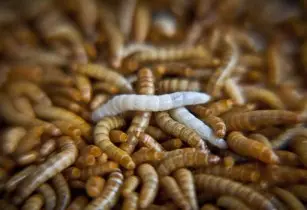Zimbabwean poultry farmers use maggots to feed their stock as the country is hit with its worst drought in 25 years
As prices for maize and soy-based feed soar due to shortages, Kuwana is producing maggots - small, white crawling worms that feed on waste - to provide protein for his breeding flock of 120 free-range chickens and 1,000 quail.
"I have struggled to find nutritious feed for quite some time now," said the 40-year-old entrepreneur, unfazed by the stink of decomposing waste filling the air and the flies swarming around.
In search of a solution, he began experimenting with maggots last September. "The results have been exceptional," he said. This business is not for the faint-hearted. For Kuwana, it involves stuffing pungent bird faeces into an old, open 20-litre plastic container, allowing flies to lay their eggs there.
Ideally, the maggot-breeding equipment consists of two containers stacked on top of each other, with holes drilled in their lids and the base of the top one. As the eggs start to hatch, the emerging larvae - the maggots - feed on the waste before crawling out to pupate in the bottom container where they are harvested and dried for feed.
Maggots consist of 65 per cent protein and 25 per cent fat, compared with 35 per cent protein in soy-based feed, according to Victor Marufu of the Zimbabwe Organic and Natural Food Association. The independent organisation trains small farmers in maggot production. "The value produced from nothing competes with supply chains that are under heavy sustainability stress," Marufu said.
One kilo of fly eggs turns into around 190 kg of dried larvae in just three days, he added. For some, maggot production may be the stuff of nightmares, but others are hailing it as a dream come true for controlling waste and climate-changing emissions. They say it could be rolled out across Zimbabwe.
"Maggots can be farmed at wastewater treatment plants where primary sludge attracts a lot of house flies," said Happymore Mbiza, an urban water systems specialist with the Chinhoyi University of Technology. A reduction in biodegradable waste feeding microbes at water treatment plants and landfill sites cuts production of methane gas and sulphur oxides, he noted.
The industrial process of producing maggot-based stock feed - using a series of tanks in a purpose-built structure - generates five times less greenhouse gas emissions than soy or maize stock feed, according to Chinhoyi University research.For every tonne of stock feed made from maggots, around two tonnes of carbon dioxide equivalent is emitted, compared with around 10 tonnes for soy-based feed.
Experts say maggot production could help cut Zimbabwe's annual emissions of 417 gigatonnes of methane, a potent greenhouse gas. In 2000, the waste sector accounted for 16 per cent of national methane emissions, government data shows. Zim Earthworm Farms, a farming technology enterprise, is now looking to go commercial with maggot production after a year of trials.
"We have been producing a sizeable amount of maggots that are killed in the biogas digester, dried and then mixed with the maize-based feed we produce," chief executive Ephraim Whingwiri told the Thomson Reuters Foundation.








